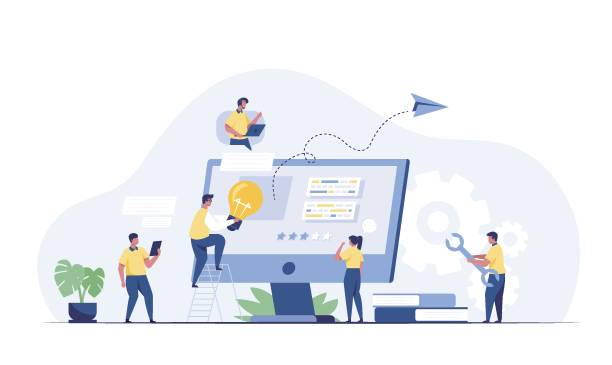The Importance of Secure Website Design in Today’s World

In today’s fast-paced digital world, #Secure_Website_Design is not just an advantage, but a vital necessity.
With the increasing cyber threats, businesses and users alike seek assurance of the #Safety and #Privacy of their data.
Security breaches can lead to the loss of sensitive information, damage to brand reputation, and heavy financial losses. This section examines why security is critically important for websites and clarifies its various dimensions for users and businesses.
Losing customer trust after a cyberattack is far more difficult than restoring systems to normal.
A secure website not only protects information but also helps create a reliable platform for online interactions.
This concept goes beyond a mere technical aspect and includes policymaking, user awareness, and continuous processes for identifying and addressing vulnerabilities.
#Website_Security should be considered from the very initial stages of design and development and should not be treated as an afterthought.
Any negligence in this area can lead to irreparable damage.
For example, #Phishing_Attacks carried out through infected websites can completely destroy an organization’s credibility and impose significant recovery costs.
Therefore, #Secure_Website_Design is a comprehensive and all-encompassing approach that covers all technical, human, and procedural aspects to protect information from threats.
Cybersecurity and secure website design are two sides of the same coin, and the success of a website depends on its security.
Did you know that 85% of customers check your company’s website before any interaction?
With Rasawb, build the corporate website that deserves your reputation.
✅ Increase credibility and customer trust
✅ Attract high-quality leads
⚡ Get free website design consultation
Familiarity with Common Website Vulnerabilities

To achieve #Website_Security, we must first become familiar with the most common vulnerabilities that threaten websites.
These vulnerabilities are weaknesses that attackers can exploit for unauthorized access, data theft, or system destruction.
Among the most important are #SQL_Injection, #Cross-Site_Scripting (XSS), #Cross-Site_Request_Forgery (CSRF), and #Broken_Authentication.
#SQL_Injection occurs when attackers inject malicious SQL code through website inputs, gaining access to the database.
XSS allows attackers to execute malicious scripts in the victim’s browser, which can lead to cookie or session information theft.
CSRF also enables attackers to send forged requests on behalf of authenticated users.
Understanding these threats and how they operate is the first step towards protecting your website and designing a secure site. This section specifically and instructively explains each of these vulnerabilities and clarifies their potential consequences for websites.
A deep understanding of these weaknesses helps developers avoid them during coding and adhere to security standards.
The OWASP Top 10 website is an excellent resource for learning about these vulnerabilities and solutions to combat them, and every developer working in secure website design should be proficient in it.
This list identifies and ranks the most critical web application security vulnerabilities and provides practical guidance for mitigating them.
Principles of Secure Coding and Attack Prevention

Secure coding forms the core of #Secure_Website_Design.
Developers must incorporate security principles into their coding process from the very beginning of the project.
This includes Input Validation, Output Encoding, Error Handling, and the use of secure libraries.
#Input_Validation means carefully checking all data entered by the user into the system to ensure the absence of malicious code or inappropriate formats.
#Output_Encoding also prevents the execution of malicious code by the browser, especially when user-generated data is displayed on web pages.
Proper error handling prevents the disclosure of sensitive system information in error messages, which can be exploited by attackers to identify vulnerabilities. Furthermore, using secure and up-to-date frameworks and libraries significantly reduces the burden on developers and prevents many common vulnerabilities.
This section provides practical and instructive secure coding techniques that help developers build websites resilient to attacks.
These measures are fundamental for any #Secure_Website_Design project, and without them, any attempt to enhance security would be superficial.
| Security Principle | Explanation | Objective |
|---|---|---|
| Input Validation | Checking and sanitizing all user inputs | Prevention of SQL Injection and XSS |
| Output Encoding | Converting special characters before display | Prevention of XSS attacks |
| Error Handling | Not displaying sensitive information in error messages | Prevention of system information disclosure |
| Using Parameterized Queries | Using prepared statements and parameters in database queries | Protection against SQL Injection |
The Importance of HTTPS Protocol and SSL/TLS Certificates

The use of #HTTPS protocol and #SSL/TLS certificates is a critical component in #Secure_Website_Design and increasing user trust.
HTTPS is the secure version of HTTP that uses SSL/TLS encryption to secure communication between the user’s browser and the website server.
This encryption prevents eavesdropping, data tampering, and identity spoofing.
SSL/TLS certificates are issued by trusted authorities and verify the website’s identity.
The presence of a green padlock icon in the browser’s address bar indicates that HTTPS is active and the connection is secure, assuring users that their information, such as passwords and credit card details, is transmitted in an encrypted form. This section descriptively and instructively examines how HTTPS and SSL/TLS work, the types of certificates (such as DV, OV, EV), and their importance in SEO and website ranking.
Google has explicitly stated that it prefers HTTPS websites in its search results, so implementing this protocol is essential not only for security but also for Search Engine Optimization (SEO).
Migrating from HTTP to HTTPS is a fundamental step towards enhancing overall website security, and all websites, from personal blogs to large online stores, should implement this change to protect their users from cyber threats.
This is an investment in the long-term credibility and stability of the website and is one of the first steps that should be taken towards #Secure_Website_Design.
Do you have an e-commerce site, but your sales are not as expected? Rasawb solves your problem forever with professional e-commerce website design!
✅ Significant increase in conversion rate and sales
✅ Unparalleled user experience for your customers
⚡ Click to get free consultation with Rasawb!
User Authentication and Access Management

One of the most important aspects of #Website_Security is the proper management of user Authentication and Authorization.
#Authentication refers to verifying the user’s identity, while #Authorization means determining the user’s access level to different system resources and functionalities.
Using #Strong_And_Unique_Passwords, implementing #Multi-Factor_Authentication (MFA) mechanisms such as SMS or authenticator applications, and securely storing password hashes are key measures in this area.
Passwords should never be stored in plain text; instead, strong hashing functions along with Salt should be used to protect user passwords even in the event of a database breach. This section, in a specialized and guiding manner, examines the best practices for implementing robust authentication systems, including the use of standards like OAuth and OpenID Connect, and also Role-Based Access Control (RBAC) approaches.
These measures not only prevent unauthorized access but also improve the user experience.
Improper access management can allow attackers to gain access to sensitive system information or functionalities by compromising an ordinary user account.
This part of #Secure_Website_Design creates a vital layer of protection against internal and external attacks and is essential for maintaining data integrity and confidentiality.
The Importance of Security Updates and Penetration Testing

Maintaining #Website_Security is a continuous process and involves regular updates and ongoing security tests.
Software, frameworks, and libraries used in websites may contain vulnerabilities that are discovered over time.
The importance of security updates lies in the fact that these updates often include patches to fix these known vulnerabilities, and failing to install them exposes the website to attacks. This section, in a news and guidance format, addresses the critical importance of continuously updating all website components, including the Content Management System (CMS), plugins, themes, and programming languages.
In addition to updates, performing periodic #Penetration_Testing and Vulnerability Scanning is also of high importance.
Penetration testing simulates real attacks by security experts to identify and fix unknown website weaknesses before they are discovered by real attackers.
These processes help identify security gaps that may have remained hidden from developers.
The information gained from these tests helps continuously improve #Secure_Website_Design and ensures that the website is always protected against the latest threats.
This proactive approach significantly reduces potential costs resulting from security breaches and preserves business credibility.
Securing the Database in Secure Website Design

The database is the heart of any website, storing sensitive user and organizational information.
Therefore, ensuring #Database_Security is an integral component of #Secure_Website_Design.
Database attacks, such as SQL Injection, can lead to theft, manipulation, or even complete deletion of information.
To protect the database, it is essential to follow best security practices, including using parameterized queries to prevent SQL Injection, applying the principle of Least Privilege for users and applications, encrypting sensitive information at rest and in transit, and continuously monitoring database activities.
Additionally, ensuring that the database is properly configured and its default ports are changed is of high importance. Regular and secure database backups are also crucial for data recovery in case of an attack or any data loss.
This section, in a specialized and guiding manner, examines practical measures for securing the database, including the use of Web Application Firewalls (WAF) to protect against common database attacks and the implementation of password management tools for database access.
Database security is a complex topic that requires extensive expertise and precision.
| Security Measure | Explanation | Benefit |
|---|---|---|
| Using Parameterized Queries | Separating data from SQL commands | Resistance against SQL Injection |
| Data Encryption | Encrypting sensitive information at rest and in transit | Protection of data confidentiality |
| Applying Least Privilege | Granting minimum necessary access to users and applications | Reduced scope of damage in case of breach |
| Regular Backups | Creating backup copies of the database | Ability to recover information after an incident |
Combating Distributed Denial of Service (DDoS) Attacks

Distributed Denial of Service (DDoS) attacks are among the most common and destructive threats against #Website_Security that can render websites unavailable and cause serious damage to businesses.
In a DDoS attack, attackers overwhelm the website server with a massive volume of fake traffic, causing it to crash or significantly slow down.
Combating these attacks requires a comprehensive strategy that includes using DDoS protection services, such as CDN (Content Delivery Network) and Cloud Firewalls. CDNs, by distributing website content across multiple servers worldwide, not only increase user access speed but also can absorb and filter malicious DDoS traffic before it reaches the main website server.
This section, descriptively and analytically, discusses types of DDoS attacks, their impact on website performance, and effective solutions for prevention and mitigation.
Furthermore, employing solutions like Rate Limiting and IP Filtering can help reduce the impact of these attacks.
Having an Incident Response Plan that includes steps for identifying, containing, and recovering after a DDoS attack is essential for any website aiming for #Secure_Website_Design.
Are you bothered by losing customers due to your e-commerce site’s outdated appearance or slow speed? Rasawb’s expert team solves these problems with professional e-commerce website design!
✅ Increased customer trust and brand credibility
✅ Stunning speed and excellent user experience
Get free consultation with Rasawb right now ⚡
Incident Response and Disaster Recovery Plan

Even with the best #Secure_Website_Design measures, the possibility of a security incident never drops to zero.
Therefore, having an #Incident_Response_Plan and #Disaster_Recovery_Plan is vital for any organization.
These plans help an organization to react quickly and effectively in the event of a security breach or data loss and resume its normal operations.
The incident response plan includes stages such as incident identification, containment, root cause analysis and cleaning of infected systems, and full recovery of information and services. Also, informing users and relevant authorities if necessary is part of this process.
This section, in a guiding and analytical manner, discusses the importance of creating and regularly testing these plans.
It includes regular and automatic backups of all website data and configurations in secure locations outside the primary access, so that in the event of a disaster such as a ransomware attack or server failure, it is possible to revert to the state before the incident.
This proactive approach and preparation for worst-case scenarios not only protects information but also helps maintain business credibility and continuity in the face of security challenges.
The Future of Secure Website Design and Emerging Challenges

The world of cybersecurity is constantly changing and evolving.
With the emergence of new technologies such as #Artificial_Intelligence (AI), #Machine_Learning (ML), and #Blockchain, new challenges also arise for #Secure_Website_Design.
On one hand, these technologies can provide powerful tools for enhancing security and automating security processes; on the other hand, attackers also leverage these very tools to develop more sophisticated and intelligent attacks.
This section, presented as thought-provoking and engaging content, explores the future of web security, emerging trends, and the challenges that developers and security professionals will face in the near future. For instance, can AI completely replace human intervention in detecting and preventing attacks? Or how can websites protect themselves against quantum attacks that might undermine current encryption capabilities? These discussions help us gain a deeper understanding of the future landscape of web security and prepare for the challenges ahead.
Integrating security into the software development lifecycle (DevSecOps), using AI techniques for anomaly detection and suspicious behavior, and adopting new security standards are all steps that must be taken to ensure #Secure_Website_Design in the future.
Frequently Asked Questions
And other services of Rasa Web Advertising Agency in the field of advertising
How to use location-based advertising for HVAC vendors
The role of content marketing advertising in attracting HVAC equipment customers
Examining the impact of social advertising on HVAC equipment sales
How to use integrated advertising with social networks for HVAC vendors
The importance of mobile marketing advertising in attracting HVAC equipment customers
And over hundreds of other services in the field of internet advertising, advertising consulting, and organizational solutions
Internet Advertising | Advertising Strategy | Advertorial
🚀 Transform your business’s digital presence with Rasa Web’s internet advertising strategies and advertorials.
📍 Tehran, Mirdamad Street, next to Bank Markazi, Kazeroun Jonoubi Alley, Ramin Alley, No. 6




